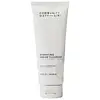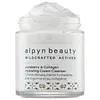What's inside
What's inside
 Key Ingredients
Key Ingredients

 Benefits
Benefits

 Concerns
Concerns

 Ingredients Side-by-side
Ingredients Side-by-side

Ethylhexyl Palmitate
EmollientWater
Skin ConditioningCaprylic/Capric Triglyceride
MaskingPrunus Amygdalus Dulcis Oil
Skin ConditioningEuphorbia Cerifera Wax
Stearic Acid
CleansingCopernicia Cerifera Wax
Glyceryl Stearate Se
EmulsifyingTromethamine
BufferingIsostearic Acid
CleansingAvena Sativa Kernel Flour
AbrasiveLecithin
EmollientDisteardimonium Hectorite
StabilisingMagnesium Aluminum Silicate
AbsorbentCoco-Caprylate/Caprate
EmollientSodium Lauroyl Sarcosinate
CleansingSorbitan Stearate
EmulsifyingKaolin
AbrasiveSaccharomyces Ferment
Skin ConditioningTriheptanoin
Skin ConditioningDecyl Glucoside
CleansingC9-12 Alkane
SolventPolyurethane-10
1,2-Hexanediol
Skin ConditioningSodium Benzoate
MaskingCaprylyl Glycol
EmollientAllantoin
Skin ConditioningTocopheryl Acetate
AntioxidantIsohexadecane
EmollientButylene Glycol
HumectantLauroyl Lysine
Skin ConditioningLauryl Glucoside
CleansingSorbitan Oleate
EmulsifyingCitric Acid
BufferingAloe Barbadensis Leaf Juice
Skin ConditioningHydroxyacetophenone
AntioxidantSodium Hyaluronate
HumectantHippophae Rhamnoides Fruit Extract
Skin ConditioningPanthenol
Skin ConditioningAnthemis Nobilis Flower Extract
MaskingCamellia Sinensis Leaf Extract
AntimicrobialEucalyptus Globulus Leaf Extract
PerfumingLavandula Angustifolia Flower/Leaf/Stem Extract
MaskingMentha Viridis Extract
MaskingPogostemon Cablin Leaf Extract
PerfumingRose Extract
Skin ConditioningQuartz
AbrasiveZingiber Officinale Extract
Skin ConditioningCurcuma Longa Root Extract
MaskingEthylhexyl Palmitate, Water, Caprylic/Capric Triglyceride, Prunus Amygdalus Dulcis Oil, Euphorbia Cerifera Wax, Stearic Acid, Copernicia Cerifera Wax, Glyceryl Stearate Se, Tromethamine, Isostearic Acid, Avena Sativa Kernel Flour, Lecithin, Disteardimonium Hectorite, Magnesium Aluminum Silicate, Coco-Caprylate/Caprate, Sodium Lauroyl Sarcosinate, Sorbitan Stearate, Kaolin, Saccharomyces Ferment, Triheptanoin, Decyl Glucoside, C9-12 Alkane, Polyurethane-10, 1,2-Hexanediol, Sodium Benzoate, Caprylyl Glycol, Allantoin, Tocopheryl Acetate, Isohexadecane, Butylene Glycol, Lauroyl Lysine, Lauryl Glucoside, Sorbitan Oleate, Citric Acid, Aloe Barbadensis Leaf Juice, Hydroxyacetophenone, Sodium Hyaluronate, Hippophae Rhamnoides Fruit Extract, Panthenol, Anthemis Nobilis Flower Extract, Camellia Sinensis Leaf Extract, Eucalyptus Globulus Leaf Extract, Lavandula Angustifolia Flower/Leaf/Stem Extract, Mentha Viridis Extract, Pogostemon Cablin Leaf Extract, Rose Extract, Quartz, Zingiber Officinale Extract, Curcuma Longa Root Extract
Water
Skin ConditioningHelianthus Annuus Seed Oil
EmollientCetyl Alcohol
EmollientGlycerin
HumectantCetearyl Alcohol
EmollientCetearyl Olivate
Sorbitan Olivate
EmulsifyingTheobroma Cacao Seed Butter
EmollientPropanediol
SolventKaolin
AbrasiveDecyl Glucoside
CleansingBakuchiol
AntimicrobialCollagen
MoisturisingJojoba Esters
EmollientAmelanchier Alnifolia Fruit Extract
Skin ConditioningSclerotium Gum
Emulsion StabilisingCetearyl Glucoside
EmulsifyingCaprylyl Glycol
Emollient1,2-Hexanediol
Skin ConditioningSodium Lauroyl Sarcosinate
CleansingAcacia Senegal Gum
MaskingXanthan Gum
EmulsifyingCitric Acid
BufferingEucalyptus Globulus Leaf Oil
PerfumingTremella Fuciformis Polysaccharide
Emulsion StabilisingSalicylic Acid
MaskingMenthol
MaskingSimmondsia Chinensis Seed Oil
EmollientGlucose
HumectantIron Oxides
CI 77491
Cosmetic ColorantCaprylic/Capric Triglyceride
Masking3-O-Ethyl Ascorbic Acid
Skin ConditioningPistacia Lentiscus Gum
MaskingHydrogenated Lecithin
EmulsifyingPhenethyl Alcohol
MaskingEthylhexylglycerin
Skin ConditioningWater, Helianthus Annuus Seed Oil, Cetyl Alcohol, Glycerin, Cetearyl Alcohol, Cetearyl Olivate, Sorbitan Olivate, Theobroma Cacao Seed Butter, Propanediol, Kaolin, Decyl Glucoside, Bakuchiol, Collagen, Jojoba Esters, Amelanchier Alnifolia Fruit Extract, Sclerotium Gum, Cetearyl Glucoside, Caprylyl Glycol, 1,2-Hexanediol, Sodium Lauroyl Sarcosinate, Acacia Senegal Gum, Xanthan Gum, Citric Acid, Eucalyptus Globulus Leaf Oil, Tremella Fuciformis Polysaccharide, Salicylic Acid, Menthol, Simmondsia Chinensis Seed Oil, Glucose, Iron Oxides, CI 77491, Caprylic/Capric Triglyceride, 3-O-Ethyl Ascorbic Acid, Pistacia Lentiscus Gum, Hydrogenated Lecithin, Phenethyl Alcohol, Ethylhexylglycerin
Alternatives
Ingredients Explained
These ingredients are found in both products.
Ingredients higher up in an ingredient list are typically present in a larger amount.
1,2-Hexanediol is a synthetic liquid and another multi-functional powerhouse.
It is a:
- Humectant, drawing moisture into the skin
- Emollient, helping to soften skin
- Solvent, dispersing and stabilizing formulas
- Preservative booster, enhancing the antimicrobial activity of other preservatives
This ingredient is an emollient, solvent, and texture enhancer. It is considered a skin-softener by helping the skin prevent moisture loss.
It helps thicken a product's formula and makes it easier to spread by dissolving clumping compounds.
Caprylic Triglyceride is made by combining glycerin with coconut oil, forming a clear liquid.
While there is an assumption Caprylic Triglyceride can clog pores due to it being derived from coconut oil, there is no research supporting this.
Learn more about Caprylic/Capric TriglycerideCaprylyl Glycol is a humectant and emollient, meaning it attracts and preserves moisture.
It is a common ingredient in many products, especially those designed to hydrate skin. The primary benefits are retaining moisture, skin softening, and promoting a healthy skin barrier.
Though Caprylyl Glycol is an alcohol derived from fatty acids, it is not the kind that can dry out skin.
This ingredient is also used as a preservative to extend the life of products. It has slight antimicrobial properties.
Learn more about Caprylyl GlycolCitric Acid is an alpha hydroxy acid (AHA) naturally found in citrus fruits like oranges, lemons, and limes.
Like other AHAs, citric acid can exfoliate skin by breaking down the bonds that hold dead skin cells together. This helps reveal smoother and brighter skin underneath.
However, this exfoliating effect only happens at high concentrations (20%) which can be hard to find in cosmetic products.
Due to this, citric acid is usually included in small amounts as a pH adjuster. This helps keep products slightly more acidic and compatible with skin's natural pH.
In skincare formulas, citric acid can:
While it can provide some skin benefits, research shows lactic acid and glycolic acid are generally more effective and less irritating exfoliants.
Most citric acid used in skincare today is made by fermenting sugars (usually from molasses). This synthetic version is identical to the natural citrus form but easier to stabilize and use in formulations.
Read more about some other popular AHA's here:
Learn more about Citric AcidDecyl Glucoside is a glucose-based surfactant and emulsion stabilizer. It is created by reacting glucose with the fatty acids from plants.
Surfactants help clean the skin by trapping oil, sebum, and dirt to be washed away. As an emulsion stabilizer, it stabilizes the ingredients in a product by preventing them from separating.
This ingredient is biodegradable and non-toxic. This ingredient is commonly found in baby shampoos.
Decyl Glucoside is sometimes used to stabilize the UV filter Tinosorb.
Learn more about Decyl GlucosideKaolin is a clay. It is used for oil control and to help minimize pores. Like other clays, kaolin has the ability to absorb excess sebum or oil. This can help clean out pores and mattify the skin.
Some types of kaolin may have exfoliating properties. When water is added to kaolin, it becomes a paste with small abrasive particles.
Most kaolin is a white color, but may be pink/orange/red depending on where it comes from.
The name 'kaolin' comes from a Chinese village named 'Gaoling'. Kaolin clay comes from rocks rich in kaolinite. Kaolinite, the mineral, has a silicate layered structure. Kaolinite is formed from chemical weathering of aluminum siilicate minerals.
Besides skincare, kaolin is commonly used to make glossy paper, in ceramics, toothpaste, and as medicine to soothe stomach issues.
Learn more about KaolinSodium Lauroyl Sarcosinate is a cleansing agent and emulsifier. It is a surfactant derived from sarcosine, and a common source is coconut oil.
As a surfactant, Sodium Lauroyl Sarcosinate helps lift dirts, oil, and other molecules to be washed away. In leave-on products, this ingredient is used as an emulsifier. Emulsifier help prevent ingredients such as oils and waters from separating.
Sodium Lauroyl Sarcosinate is also commonly found as a foaming agent in shampoo, toothpaste, and shaving foam. It is amphiphilic, meaning it loves both water and fats.
Learn more about Sodium Lauroyl SarcosinateWater. It's the most common cosmetic ingredient of all. You'll usually see it at the top of ingredient lists, meaning that it makes up the largest part of the product.
So why is it so popular? Water most often acts as a solvent - this means that it helps dissolve other ingredients into the formulation.
You'll also recognize water as that liquid we all need to stay alive. If you see this, drink a glass of water. Stay hydrated!
Learn more about Water